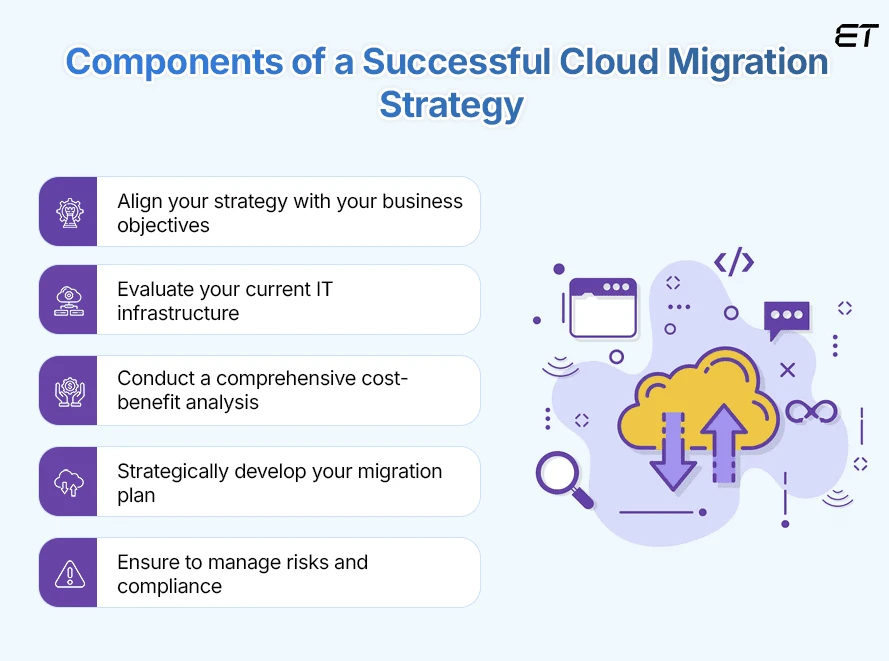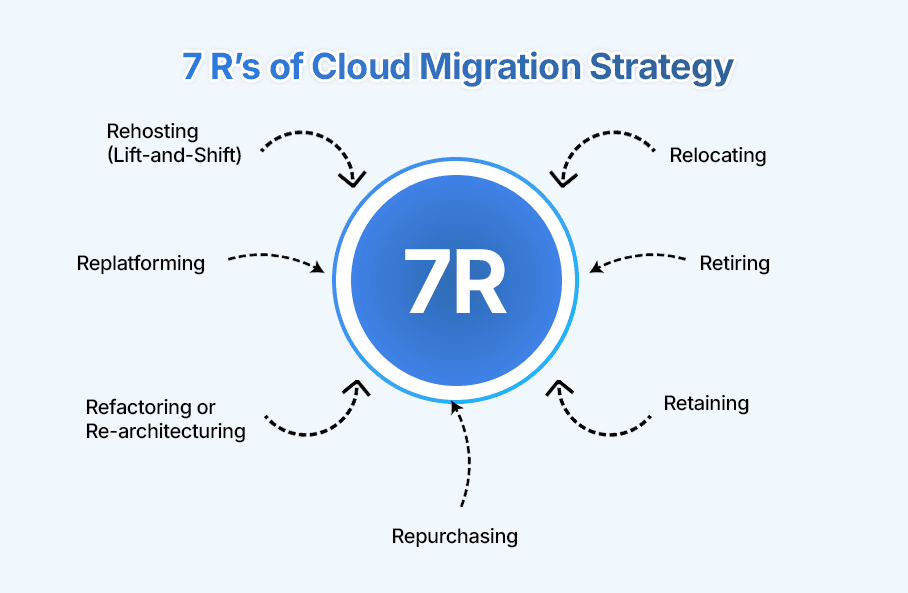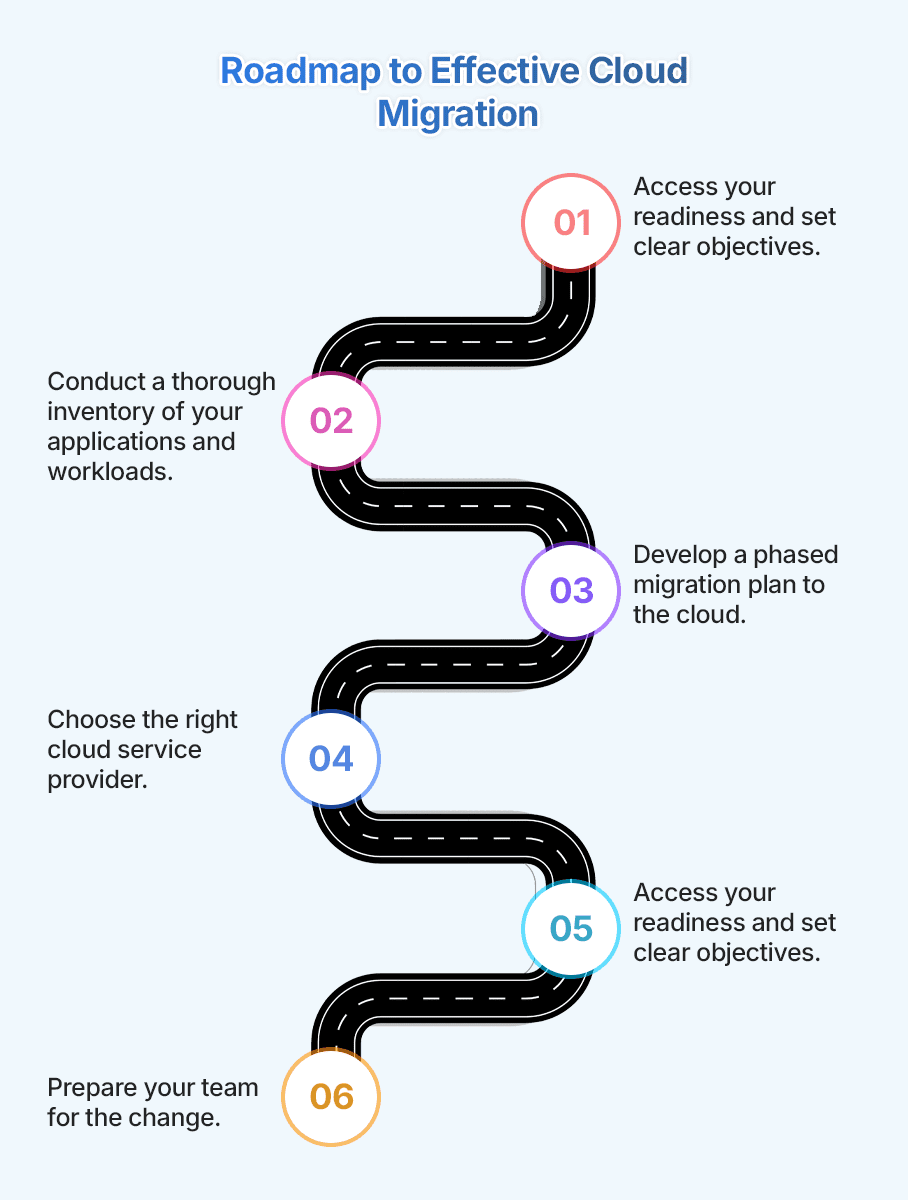
Cloud Migration Strategy: Transition to Cloud with Confidence in 2025
Gone are the days when businesses relied on bulky on-premises servers to store and manage their data. Today, everyone wants flexibility, scalability, and cost-efficiency. And guess what? Cloud migration offers it all!
However, making the leap to the cloud isn’t as simple as flipping a switch. A poorly planned migration can lead to increased costs, operational downtime, and security vulnerabilities. And no business can afford to face these issues.
This is why having a strong cloud migration strategy is essential. Think of it as a roadmap that guides your business through the complexities of cloud adoption, ensuring every step aligns with your business goals and mitigates risks.
So, how do you approach a seamless cloud migration? In this blog, we’ll guide you through the essential steps to ensure a successful cloud migration and maximize the benefits for your business.
Without wasting much time, let’s start with the basics of cloud migration and then move on to the other sections.
What is Cloud Migration?
Cloud migration is the process of moving a company’s digital assets—such as data, applications, and IT resources—from an on-premises infrastructure or legacy systems to cloud-based environments. It’s not just about moving your storage or applications from one place to another; it’s a strategic shift that involves careful planning and execution to achieve optimal results.
Cloud migration aims to leverage the benefits of the cloud—scalability, flexibility, cost-efficiency, and enhanced security—while minimizing disruptions to your business. However, it requires a well-defined strategy and careful consideration of factors such as data security, compliance, and integration with other systems.
Let’s understand this with a real-world example of a leading financial institution, Capital One. They undertook a cloud migration strategy to move its operations from eight on-premises data centers to Amazon Web Services (AWS). This migration allowed Capital One to increase its security posture, improve their data analytics capabilities, and deliver more personalized experiences to their customers. By migrating to the cloud, they reduced their operational costs and are able to innovate rapidly in high competition.
Want to learn more about cloud? We’ve got you covered! Explore our guide on cloud maturity models here!
Types of Cloud Migration
Now that you know what cloud migration is, let’s have a look at its types. So basically, there are four types of cloud migration that includes:

1. Public Cloud Migration
Public cloud migration involves moving your business data and applications to a third-party cloud provider like AWS, Microsoft Azure, or Google Cloud. This type offers your business scalability, flexibility, and cost savings, as you only pay for the resources you use. However, depending on your industry requirements, it may have limitations regarding data privacy and compliance.
2. Private Cloud Migration
Private cloud migration involves shifting your business data and applications to a cloud environment that is dedicated to only one organization. This type provides your business with enhanced security, control, and customization, making it ideal for those with strict data compliance requirements. However, it can be costly compared to the public cloud due to the need for dedicated infrastructure.
3. Hybrid Cloud Migration
Hybrid cloud migration combines both public and private cloud solutions, allowing you to balance cost, scalability, and control. You can keep your sensitive data on private servers while also utilizing the public cloud for your less-critical workloads. This type offers your business flexibility and a tailored approach. However, it requires you to manage carefully to ensure seamless integration between environments.
4. Multi-Cloud Migration
Multi-cloud migration is when you can use multiple cloud services from different providers, such as AWS, Azure, and Google Cloud, to optimize your data and applications performance, reduce risk, and avoid vendor lock-in. This type allows you to pick and choose the best features from each provider. However, it requires strong management skills to handle different platforms and ensure consistent security and compliance.
Components of a Successful Cloud Migration Strategy
A successful cloud migration strategy is not one-size-fits-all. You need to customize it to fit your business needs. Below are the core components:

1. Aligning with Business Objectives
Before you get into the technicalities, it’s first crucial to align your cloud migration strategy with your business goals. Are you looking to reduce costs, improve scalability, or accelerate your time to market? Setting clear objectives will guide every decision in your migration journey.
2. Evaluating Your Current IT Infrastructure
Next, you need to thoroughly assess your existing IT infrastructure, including applications, databases, workloads, and dependencies. This will enable you to understand your current state and help you identify which workloads are cloud-ready and which need modification or reconfiguration.
3. Cost-Benefit Analysis
Conduct a comprehensive cost-benefit analysis, as it is essential for you to understand how to reduce your operational costs and choose the right model for your business. Understand both the upfront costs and long-term savings associated with different cloud models. This includes evaluating the Total Cost of Ownership (TCO) and Return on Investment (ROI) for your cloud adoption.
4. Developing a Migration Plan
When you start with developing a migration plan, there are several aspects you need to consider and work on as it’s the most important step. Let’s take a look at them point-wise so it’s clear for you to understand and remember:
- First thing first, break down the migration process into clear phases with specific timelines and milestones. This will keep you on track and make it easy for you to track progress.
- Next, develop back up plans for potential risks such as data loss, downtime, or integration issues. This will ensure that your business is running smoothly without any interruptions.
- Then, determine the data transfer method. For this, choose the most efficient data transfer method, such as online transfer, offline transfer, or hybrid, based on your data volume and network capabilities.
- Before you move forward with transferring all your data, conduct a pilot migration or use a testing environment to identify potential issues. This will enable you to optimize the process before full-scale implementation.
By ensuring these basic steps you can develop a full-fledged and efficient cloud migration strategy for your business without affecting its continuity.
5. Managing Risks and Compliance
If you’re a decision-maker, we are aware that your top concerns are security, data privacy, and regulatory compliance. Therefore, it’s essential to ensure a strong cloud computing migration strategy. You must address these by incorporating data encryption, identity and access management (IAM), and regular audits in order to ensure compliance with your industry regulations.
Is your business ready to scale effortlessly? Discover the secrets of scalability in cloud computing and see for yourself how it can drive your growth.
The 7 R’s of Cloud Migration Strategy
As we discussed earlier, the cloud migration journey involves more than just moving applications and data—it requires strategic thinking to ensure your cloud environment is optimized for performance, cost-efficiency, and scalability. But how?
This is where the 7 R’s of cloud migration come into play. Each ‘R’ represents a different migration approach, offering a tailored path based on your business needs, application complexity, and long-term goals.

Let’s understand them in detail below:
1. Rehosting (Lift-and-Shift)
Rehosting is the starting point for many organizations venturing into cloud migration. In this approach, you ‘lift’ your existing applications and infrastructure from their current environment and ‘shift’ them to the cloud. It’s just like shifting something into a new environment without having to change its design or anything.
This method is fast and requires minimal changes to the existing codebase, making it a low-risk, cost-effective option. However, it doesn’t optimize applications for the cloud environment, potentially missing out on cloud-native features like auto-scaling and load balancing.
2. Replatforming
Replatforming is a step up from rehosting. While you still move the application to the cloud, you make some optimizations along the way to take advantage of cloud capabilities. These changes are minimal but can significantly improve performance or reduce costs. For example, you might switch to a managed database service or introduce auto-scaling to handle varying loads better.
Replatforming provides a balance between minimal disruption and some level of optimization, making it a popular choice if you’re looking to improve efficiency without overhauling your entire system.
3. Refactoring (Re-architecturing)
Refactoring, or re-architecturing, is the entirely different and most involved approach as compared to the first two. This approach requires a complete overhaul of applications to become cloud-native. This means you must redesign your applications to fully leverage cloud-native features such as microservices, serverless computing, and containerization.
While refactoring is resource-intensive, it offers you the highest level of scalability, flexibility, and agility, enabling your business to innovate rapidly. This approach is ideal if you aim to achieve a competitive edge through digital transformation and are looking to future-proof your IT infrastructure.
4. Repurchasing
In the repurchasing model, you move from a traditional on-premises software license to a cloud-based Software-as-a-Service (SaaS) model. Instead of migrating an existing application, you replace it with a new, cloud-native solution. For example, switching from a legacy CRM system to a cloud-based service like Salesforce.
Repurchasing can simplify your tech stack and reduce the burden of maintaining that same old, outdated software. It is a preferred choice if you’re looking to modernize your operations quickly.
5. Retaining
Sometimes, migrating all your applications to the cloud isn’t possible or necessary. In that case, the retaining model allows you to keep certain critical applications or systems on-premises due to regulatory, security, or business-specific reasons.
This approach is suitable for workloads that may not be cloud-ready or require significant customization that a cloud environment cannot support. Retaining allows you to adopt a hybrid model where cloud and on-premises systems coexist harmoniously.
6. Retiring
In the process of cloud migration, you may identify applications or systems that are outdated, redundant, or no longer provide value to your business. There’s no use in keeping and paying for such systems, right? Then what do you do?
You retire these applications, which means you decommission and remove unnecessary workloads to focus on more important applications that drive your business value. It helps you streamline your IT portfolio and reduce costs. It’s a strategic decision to declutter and enhance your business efficiency.
7. Relocating
Relocating involves moving your applications or workloads from one cloud provider to another without significantly changing your architecture. This approach is helpful if you want to take advantage of better pricing, enhanced features, or improved performance offered by a different cloud provider.
Relocating can optimize your cost and performance, but it requires careful planning to manage potential challenges like data transfer, compatibility issues, and downtime. It’s an effective way to refine your cloud strategy while maintaining flexibility and control.
Each of the strategies discussed above has its own strengths and weaknesses. However, the choice depends on your business’s specific needs and requirements. First, evaluate carefully what your business needs and what better suits it, and then move ahead with the chosen strategy.
Explore the ultimate guide to top cloud migration tools and tips you need in 2025.
How to Craft a Cloud Migration Roadmap for Your Business?

Creating a cloud migration strategy or roadmap is like planning the entire journey, which requires clear direction, preparation, and a step-by-step approach to ensure you reach your destination smoothly. This roadmap is crucial for your business to minimize risks, avoid unexpected costs, and ensure a seamless transition to the cloud.
So, where do you start?
#1 Access your readiness and set clear objectives.
Begin by evaluating your organization’s readiness for cloud adoption. What are your primary goals—cost savings, scalability, better security, or faster innovation? Define these objectives clearly as it will help you set the right expectations and align the migration with your business strategy.
#2 Conduct a thorough inventory of your applications and workloads.
Before moving to the cloud, it’s essential to take stock of all your current applications, data, and workloads. Identify which ones are cloud-ready and which might need modifications or upgrades. This step helps you prioritize what to migrate first and how to handle potential complexities.
#3 Develop a phased migration plan to the cloud.
If you want to avoid disruptions and complexities, then ensure to follow a phased approach. Start with non-critical workloads to test the waters, then gradually migrate more essential applications and data. This strategy minimizes your risks and allows for real-time adjustments and optimizations based on early feedback.
#4 Choose the right cloud service provider.
Selecting the right cloud service provider (CSP) is important. It’s more than just a pricing decision; it involves evaluating their service levels, security features, compliance capabilities, and support structure based on Service Level Agreements (SLA). A good CSP can provide the backbone of a successful cloud data migration strategy for a smooth migration experience, offering tools and expertise to simplify the process.
#5 Plan for data security and compliance beforehand.
Data security is a top priority during cloud migration. Ensure your roadmap includes strong security measures like data encryption, access controls, and compliance checks to protect sensitive data. Regular audits and monitoring should also be part of your plan to detect and resolve issues promptly.
#6 Prepare your team for the change.
Migration is not just a technical shift but also a cultural one. Therefore, equip your teams with the necessary training and resources to adapt to new cloud tools and processes. A well-thought-out change management plan can help ease this transition for you, ensuring everyone is on board and ready.
Wrapping Up!
As we wrap up, we hope this blog helps you understand cloud migration strategy and how to create a smooth roadmap for your transition. A well-planned cloud migration strategy acts as your compass to overcome the complexities of cloud adoption while maximizing benefits like scalability, cost-efficiency, and enhanced security.
But remember, the journey doesn’t end with migration — it’s about continuous optimization and alignment with your business goals.
Are you ready to take the next step and utilize the full potential of the cloud migration strategy? Let’s connect and discuss your cloud migration strategy together!
Frequently Asked Questions
How long does a cloud migration typically take?
Migrating to the cloud can vary significantly based on the complexity of your system and the amount of data you’re moving. It also depends on the migration strategy you choose. Typically, it can range from a few weeks for simpler projects to months or even years for complex ones.
What are the cost considerations when planning a cloud migration?
Cost considerations for cloud migration include initial setup costs, potential downtime costs, training for teams, ongoing cloud service fees, and costs associated with optimizing and managing cloud environments post-migration.
Can all types of applications be migrated to the cloud?
No, not all applications are suitable for cloud migration. For example, legacy systems with specific dependencies, applications that require high performance, or those heavily reliant on certain hardware might face challenges when moved to the cloud. Therefore, always check if your applications are cloud compatible or not.
How do I minimize downtime during cloud migration?
To minimize downtime during cloud migration, you can follow a phased approach by migrating non-critical applications first, perform extensive testing in a parallel environment, and then move on with the important and critical ones.





